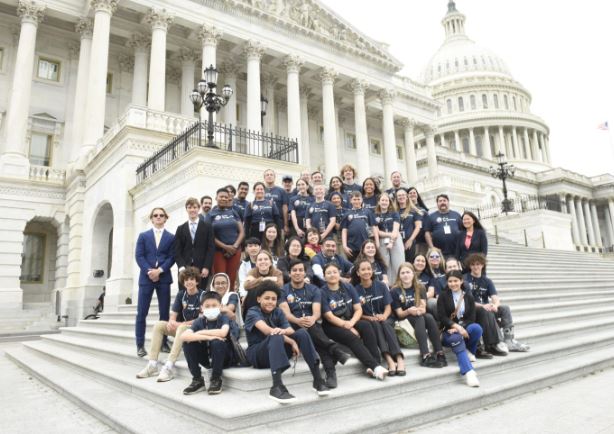
Ask any STEM teacher, and I think they’ll tell you the same thing: The hardest part of judging a student STEM competition is keeping your judge hat on and not slipping back into teacher mode. That was certainly my experience judging the final round of the 13th annual Samsung Solve for Tomorrow competition for middle- and high-school teams in Washington, DC. It was so hard for me to maintain that dispassionate judge’s perspective — to contain my excitement about what these kids were working on, how innovative they were and what they were accomplishing as they grappled with using STEM to fix problems they saw in their communities.
Middle-school students in high-level meetings
This was brought home for me by the students from Liberty Avenue Middle School in Brooklyn, N.Y., as they pitched their “Subsave” public transportation safety alert app to our judging panel. The app is meant to work along with the existing MTA Help Point communication system to support commuters by discreetly reporting a mental health emergency to mobile mental health responders. They nonchalantly mentioned that, after “our second meeting with the MTA,” they adjusted their design to take that agency’s comments into account.
As a teacher, it was hard to contain myself: These middle-schoolers had a second meeting with leadership of the subway division of New York City’s Metropolitan Transportation Authority — the most extensive subway system in the world. Their ideas were being taken seriously by local government. And it just seemed perfectly normal to them.
But putting my judge hat back on, I just calmly asked them to elaborate on that point to help emphasize for them and for my fellow judges what a significant milestone they had achieved.
That’s the power of a program like Solve for Tomorrow and STEM challenges in general. They empower young learners to think expansively, to go the extra mile, to learn more about what they can do if they put their minds and hearts into it. To realize that their ideas have merit and deserve attention. And to believe that’s exactly how it should be.
Local problems with global ripples
After my judging stint, I was asked if I had noticed common themes among the projects that were being pitched to us by the competition’s 10 national finalists. I replied that there was an overarching theme: “Find a need; fill a need.” That’s what these teams were doing. They were identifying problems and issues that were of concern to them and their communities, focusing on hyperlocal matters and applying their STEM skills to craft creative and innovative solutions. In that process of filling a local need, they typically developed a solution that had global implications.
It’s an unfortunate reality of today’s world that kids often focus on scary things. In prior years, solutions addressing school shootings were pretty common entries in these competitions. A look at the pitches we listened to last month shows several clear trends:
- Community mental health challenges were top of mind for the two middle-school teams that made it to the finals. In addition to the New York City Subway alert system, Georgia students who live near several military bases developed a monitor and app to stop night terrors for PTSD sufferers.
- Climate/environment-induced dangers sparked the greatest number of proposals from these highly motivated young people, including solutions to prevent heat-related illness in school athletes, reduce temperatures in urban heat islands, combat river pollution, and monitor the health of beehives to prevent pollinator collapse.
- Concern for distressed community members ran throughout the proposals. Other projects pitched to us were solar-powered sleep mats for unhoused refugees, meals for the food insecure, affordable assistive tech for the mobility challenged and a navigation aid for lost spelunkers.
I was also asked if, as a teacher, I think competition is the right approach for a learning environment. I have thought about the possibilities of a competition versus a collaboration — a science fair where participants all share ideas and work toward common goals. But at the end of the day, I do believe competition is built into our culture. In many ways, competition drives innovation. It helps you learn how to marshal finite resources. It forces you to prioritize. That is all good preparation for the world outside the classroom.
Meanwhile, the STEM competitions my classes enter don’t really have any losers. We have winners and learners. If you don’t win, you learn, and you can apply what you learn to future projects. Learners get to come back the next year, as my teams have, to be winners in future editions of these competitions.
Failure isn’t always an option in resource-challenged schools
As a teacher in a resource-challenged community (who can now add “judge” to my resume), I also want to add a comeback to those who say that “fail often” should be a mantra in the tech space. Psychologically, it’s good for students to get beyond attaching a stigma to “failure.” But the luxury of failing isn’t equally shared across American education. Some school districts can afford to fail and fail again before getting things right with a project. Some have ample equipment and can afford to replace things that break. Elsewhere, teachers have to make do with what’s on hand or what they can afford to supplement out of their own pockets. A single failure in a project may be the end of the line, at least for that school year. That’s a very real worry for many of our STEM educators, and it’s hard for teachers to avoid passing that worry along to students.
That’s why programs like Solve for Tomorrow are so important. They provide a very real supplement to the limited resources available for STEM programs in many districts. Five of the 10 national finalists who pitched us were from Title 1 schools: teams from under-resourced communities who made it to the upper levels of competition. Even those that didn’t achieve top prizes had earned valuable tech and classroom supplies along the way. And most importantly, they learned that they — and their ideas, their skills and their concerns for the communities — are valued in the world outside their classrooms.
What can all of us do to help support STEM education across the country, especially in resource-challenged schools? Three ideas come to mind. Enter national STEM competitions like Solve for Tomorrow, check with your employer to encourage support for local STEM education programs, and head to DonorsChoose to make a donation to a classroom STEM project near you.
Harry Preston is a computer science teacher at Green Street Academy in Baltimore. His class was a past Samsung Solve for Tomorrow national finalist, and he is an alumnus of Solve for Tomorrow’s Teacher Academy professional development program.
Opinions expressed by SmartBrief contributors are their own.
_________________________
Subscribe to SmartBrief’s FREE email newsletter to see the latest hot topics on EdTech. It’s among SmartBrief’s more than 250 industry-focused newsletters.
